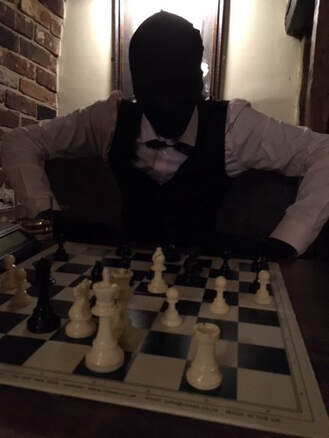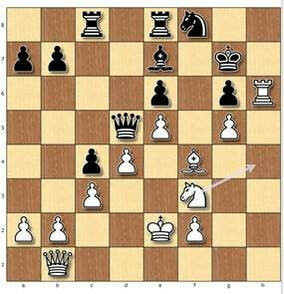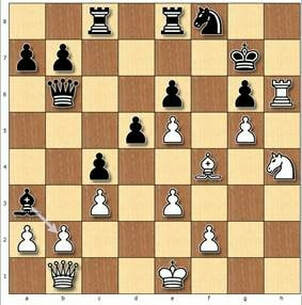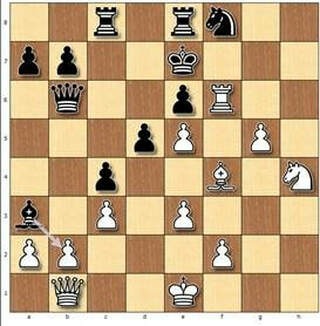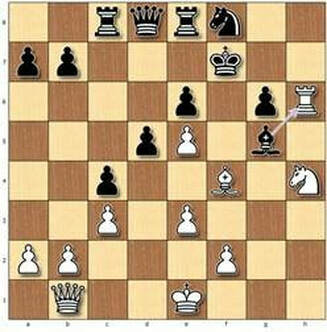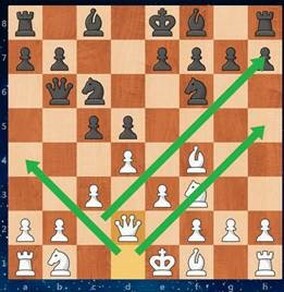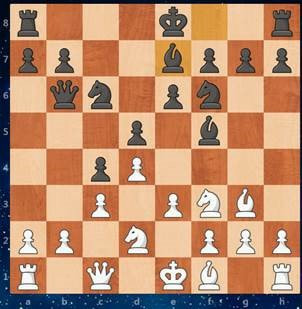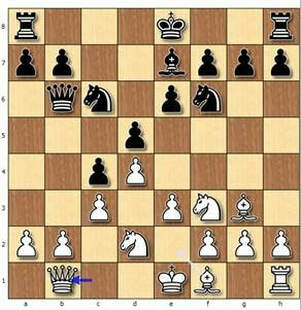Vara V Abbott Analysis (Seb Parker)
|
I thought that Javier’s summary [part of which below] was pretty much spot on, to me the most critical part of the game was black failing to find the correct defence.
But since Gerry requested analysis, I guess that a deeper nit-pick of how the game developed to the point where black only had one move is what is desired. So I’ve written about 2000 words on the game, is that what you wanted Gerry?! I’ll start by just talking a little bit [way too much!] about the critical defence after 22.Rh6. Knight on f8, cannot be mate Here is the position after 22. Rh6:
|
|
There isn’t much more white can bring immediately, needing 2 moves to bring Nf3-h4 to bring another attacker onto g6. Therefore if black can defend g6 with 1 more piece, black will get another move to help the king i.e.
22 … Nf8 23 Nf3 ___ 24 Nh4 And this is the really hard bit I think. The disadvantage of Nf8 is that black’s rooks and queen are totally blocked out of the defence, for example Rh8 could be very strong in some lines, and if black makes a pointless move like 23 … a6 then white is winning after taking on g6 on move 25. So finding Nf8 is not enough by itself, and this is what makes it difficult to play 22 … Nf8. So how do we reason to the winning idea for black at move 23? Well... black is quite cramped, there aren’t too many moves to analyse so let’s look at some candidate ideas: First let’s look what happens when we counterattack by trying to open up the centre: 22 … Nf8 23 Nf3 d4 24 exd4 (Nxd4 would be a mistake because it puts the knight further from attacking g6 and allows the fork Bxg5) 24 … Qd5 (threatening Qh1+ if Nh4) 25 Ke2 (protecting the knight and preventing the Qh1+) This line is quite forcing, so we can be assured of reaching the position below, but is it any good? |
|
I’m not sure we’ve accomplished too much here, our pawn structure has been compromised, the queen on d5 isn’t contributing to defending g6, and has no infiltration squares after Nh4 (e4,f3,g2 and h1 are all defended) The main idea I can see is something like Bg8-b6-d4, sacrificing the bishop to further open up the centre while also unblocking the 7th rank for the king to run away. It might work, but that is a lot of moves to calculate over the board from the position at move 22, and the threat of Nh4, Rxg6+ and forcing lines is a headache. So I would say that d4 is risky and unclear. |
|
Let’s look at another counterattack – on the queenside with:
22 … Nf8 23 Nf3 Qb6 24 Nh4 Ba3 |
|
The bishop moves out of the way, unclogging e7 to give the king an escape route. Also see that the b pawn is pinned, so white has a couple of ideas:
Push b3 is terrible for white, because cxb3 brings black’s rook into the counterattack. Nxg6 is going to be too slow because black can play Qxb2, disrupting white’s queen, so the continuation is: |
|
25 Rxg6+ Kf7 (If black were to take with Nxg6, this allows white’s queen to enter the attack, a little too dangerous… instead black can try to run away)
26 Rf6+ Ke7 |
|
At move 27 white has a few options, including the spicy Nf5+ (rook pins e-pawn because queen on b6), so calculating onwards over the board would be tough since we’re already 5 moves deep, but this line looks like black’s king gets to escape, and black’s pawn structure is strong in the centre. Maybe white’s g-pawn would become very strong, but if it is that scary, black can afford to sacrifice a piece if needed to stop the pawn. And black has threats on b2. So I like the look of this counterattack a little more than the d4 push, both give white opportunities to make mistakes, but black still isn’t sitting pretty! |
|
The final move I will examine is tricky to find, but computer tells me it is the best move:
22 … Nf8 23 Nf3 Kf7 24 Nh4 Bxg5!! |
|
This fork takes enough out of white’s attack, by either forcing the knight or rook off, reducing pressure on g6, or if bxg5 then Qxg5 brings the crucial third defender of g6. And white doesn’t have a forcing line with 25. Rxg6 because it is no longer check and black can take the knight. However, all this calculation is far too anxiety inducing for me, I would rather avoid getting into such a tense position in the first place. [noted, Ed] |
|
The Opening
1. d4 Nf6 2. Bf4 d5 3. e3 c5 4. Nf3 Nc6 5. c3 Qb6 6. Qd2 ? This is the wrong queen move for several reasons. A key concept in this opening structure, with the c3-d4-e3 pawn triangle, is to put your “bad” bishop outside of the pawn chain. What makes the bishop bad is that it is on the same colour squares as the pawns, and therefore has restricted movement, so putting it outside of the pawn chain gives it a bigger range of influence instead of being trapped behind the pawns. The “good” bishop is the white-square bishop, which can move in and out of the pawn structure with relative freedom. Why am I talking about bishops? Well the queen also moves like a bishop, and in this structure you would much prefer the queen to be on a white square so that it can influence a much wider range of squares. |
|
A typical square for the queen is c2, which gives influence on the queenside and also the b1-h7 diagonal.
The second reason is that c3 is blocked, so the natural square to develop the b1 knight is d2. Unless the knight is to go to the particularly weak a3 square, (where black may trade for the f8 bishop , crippling white’s pawn structure) white will have to move the queen again if he is to develop on the queenside. Thirdly, the queen on d2 allows black to gain a tempo with Ne4 in some aggressive lines. |
|
6... c4
7. Bg3? ( 7. Be2) Bg3 is a weird move here – it breaks an opening principle – don’t move a piece twice in the opening , and black wasn’t directly threatening the bishop. Sometimes black can play Nh5 against a bishop on f4, but Bg3 doesn’t stop that threat so I don’t see any reason to play Bg3 instead of the obvious developing move Be2. The white-square bishop cannot develop to another square, like d3, so it’s likely Be2 is coming at some point, and this seems like a good moment, since the b1 knight is blocked from going to d2), the other quiet option is h3, preventing black’s pieces coming to g4, or even better is to reclaim space on the queenside with b3 (although the b3 plan is a bit better if the queen is on the d1-a4 diagonal). 7.... Bf5 8. Qc1 (a depressing move considering my comments on 6.Qd2, c1 is also a horrible square for the queen because her only role is defending b2, she is almost demoted to a pawn) 8…e6 9. Nbd2 Be7 |
|
At this point, black has developed all his pieces, his bishop is outside the pawn chain (on f5), and he has the option to castle either side. White has wasted multiple tempi on moving the queen to bad squares and moving the black-squared bishop to g3. It seems to me that black has clearly played a better opening than white. |
|
10. Rb1 ??
A blunder, a normal move would be 10. Be2, but also possible is Nh4 to eliminate the f5 Bishop, or h3, to give escape for the g3 bishop against Nh5, and restrict the scope of Nf6 and Bf5. After 10 … Bxb1 10... Bxb1 11. Qxb1 – On the plus side, the queen finally arrives on a white square, eyeing a very nice diagonal to h7. |
|
11 …O-O
The computer won’t tell you that O-O is a blunder because the computer also knows how to defend perfectly against white’s attack. But this move plays right into the only plan that gives white good winning chances, so I really don’t like it. Since black is ahead in development and in material, black can afford to be patient here and let white commit some moves before deciding if castling kingside is a good idea. For example if white plays Be2 and O-O, then black can also castle kingside and then push pawns on the queenside to open up files and take advantage of the pair of rooks. However if white doesn’t play O-O and starts pushing h and g pawns then black will be very glad to have left options open. Additionally, since the centre is closed, the king is relatively safe even without castling, since in closed centre positions, attacks tend to happen on the wings. 12. Ne5 Qd8 13. Be2 Rc8 14. h4 h6? Another key idea when defending an attack on a castled king is not to move pawns in front of your king. The reasons for this are:
15. Bf4 (revealing the pointlessness of 7.Bg3 – white now wastes a turn moving the bishop back to it’s proper place) 15… Re8 (I would have preferred Bd6, threatening trades and vacating the e7 square to help the c6 knight aid in the defence) 16. g4 Nxe5 17. dxe5! (Great idea to kick the knight away from defending the king) 17 … Nd7 18. g5 hxg5 (If the h6 pawn was on h7, white wouldn’t have a hook to open files, and will have to spend more moves to get the pawns to the 6th rank, at which point black could keep the files closed by advancing the right pawns) 19. hxg5 g6 20. Bh5 (Excellent idea from white – in for a penny, in for a pound, you’re only winning if you’re giving checkmate so why not sacrifice more material to open up that king!) 20 … gxh5 looks like suicide. So Black knows that Bxg6 is coming next, therefore his move 20 must defend g6. He has two options – Kg7 or Nf8. Kg7 opens the 8th rank for the rook to come across, but as discussed at length, after 22.Rh6 black will not have time to move the rook over. The computer assesses black as very far ahead and easy to play (many moves available) after the variation 20. … Nf8 21. Bxg6 Nxg6. I suppose white doesn’t have to play 21. Bxg6, but if he doesn’t then Bh5 looks like a very strange move. 20 … Kg7 21. Bxg6 fxg6 22. Rh6!! So although black was doing better in the first 10 moves, from move 11 white has figured out a clear plan and committed to it, while black didn’t improve his position, and even helped white to have a better attack. Black could still have escaped with precise defence tactics, but without a string of positional mistakes, black would have had a much easier time of it. Fin. Pgn with sparse annotation attached. Sebastian |
